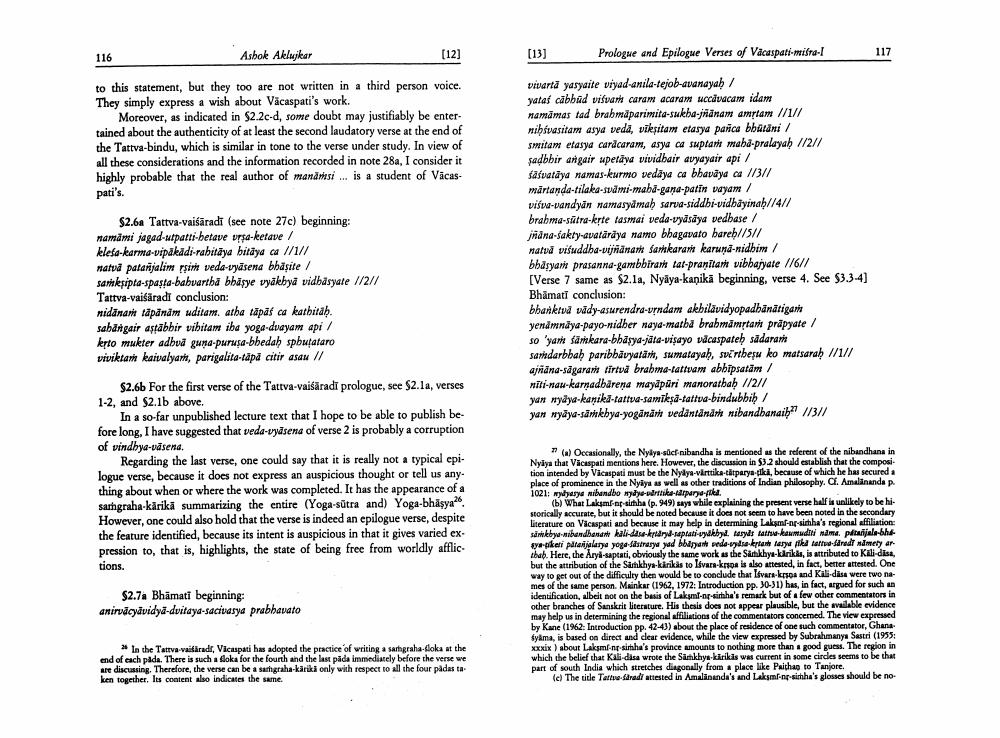Book Title: Prologue And Epilogue Verses Of Vacaspati Misra I Author(s): Ashok Aklujkar Publisher: Ashok Aklujkar View full book textPage 7
________________ 116 Ashok Aklujkar [12] (13) Prologue and Epilogue Verses of Vacaspati-mira-1 117 to this statement, but they too are not written in a third person voice. They simply express a wish about Vacaspati's work. Moreover, as indicated in 52.2c-d, some doubt may justifiably be enter tained about the authenticity of at least the second laudatory verse at the end of the Tattva-bindu, which is similar in tone to the verse under study. In view of all these considerations and the information recorded in note 28a, I consider it highly probable that the real author of manāmsi ... is a student of Vilcaspati's. $2.68 Tattva-vaisāradi (see note 27c) beginning: namāmi jagad-utpatti-betave ursa-ketave / klesa-karma-vipakadi-rabitaya bitaya ca 1/1/1 nati patanjalim psime veda-vyāsena bhasite/ sanksipta-spasta-babvartha bhāsye vyakbya vid basyale 1/2/1 Tattva-vaisäradi con midananir tāpanām uditam atba tapas ca karhitdb. sahangair astābbir vihitam iba yoga-duayam api / kerto mukter adbud guna purusa-bhedah spbuataro viviktan kaivalyan, parigalita-täpă citir asam // vivarta yasyaite vryad-anila-tejob-avanayah / yatas cabbad vifunt caram acaramuccdecan idam namāmas tad braubmaparimita-sukha-riānane amptan //1// nisvasitam asya veda, vikesitame etasya parica bbadni/ smitam etasya cardcaram, asya ca suptan mahd-pralayah 7/2/1 sadbir antgair upetāya vividhair avyayair api/ safvaldya namas-kurmo vedāya ca bhavaya a 1/3// mārtanda-tilaka-suami-maba-gana-patin vayam / visma-vandyan namasydmah sarva-siddhi-vidhāyinah//4// brahma-sätra-kpte tasmai veda-vyāsāya vedbase/ jñana-sakry.cpataraya namo bhagavato bareb//5// nată vifuddha-urjänan Samkaram karuna-nidhim/ bbasyaris prasanna-gambbirant tat-pranita vibhayale 1/6// [Verse 7 same as $2.1a, Nyāya-kaņikā beginning, verse 4. See $3.3-4] Bhamati conclusion: bbankrud vidy-asurendra-vindam akbilāvidyopadhandrigante yenindya.payo-nidber naya-matba brahmamptant prapyute/ so 'yanis sarkara-bhasya-jāta-visayo vdcaspateh sadaran sanidarbhah paribhavyata, sumatayah, surtbe ko matsarah //1// ajridna-sdgarant firta brahma-lattvam abhipsatam/ niti-nau-karmadbarena mayāpāri manorathah 1/2/1 yan wydya-kanika-tattwa-samīksā-tattua-bindubbih / yan wydy-sdkbya-yoganän vedantanath Nibandhanaiba 1/3// $2.6b For the first verse of the Tattva-vaišāradi prologue, see $2.1a, verses 1-2, and $2.1b above. In a so-far unpublished lecture text that I hope to be able to publish before long. I have suggested that veda-uyasena of verse 2 is probably a corruption of vindbya-pasena. Regarding the last verse, one could say that it is really not a typical epilogue verse, because it does not express an auspicious thought or tell us any. thing about when or where the work was completed. It has the appearance of a sangraha-karikā summarizing the entire (Yoga-sútra and) Yoga-bhäşya26 However, one could also hold that the verse is indeed an epilogue verse, despite the feature identified, because its intent is auspicious in that it gives varied expression to, that is, highlights, the state of being free from worldly afflic. tions. () Occasionally, the Nyly sc nibandha is mentioned the referent of the nibandhana in Nykya that Vicaspati mentions here. However, the discussion in 32 should establish that the composi tion intended by Vacaspati must be the Nykya-virttika-citaryck, because of which he has secured a place of prominence in the Nyaya as well as other traditions of Indian philosophy. . Amalananda p. 1021: w ye mibandbojo-driks-airpers-old (b) What Lakamin ittiha (p. 949) says while explaining the present verse half is unlikely to be hi Morically accurate, but it should be noted because it does not seem to have been noted in the secondary Literature on Vacaspati and because it may help in determining Lakamf-ne-sirtha's regional affiliation: skby windheng bali-dw.kpdryd-saplati-odbyd. My Makamuditi nama petajale-bhe * y keli patrijalarga yoga-Sastrasya yad bipante pedo-codsaktan tarye il latte-fredy ndmety ar ihab. Here, the Aryl-saptati, obviously the same work as the Sathya-karikas, is attributed to Kali-disa, but the attribution of the Sankhya-karikas to Isvars-krson is also attested, in fact, better attested. One way to get out of the difficulty then would be to conclude that Ivar Krsoa and Kalidasa were two names of the same person. Meinkar (1962, 1972: Introduction pp. 30-31) has, in fact, argued for such an identification, albeit not on the basis of Laksmi-ne- s he's remark but of a few other commentators in other branches of Sanskrit literature. His thesis does not appear plausible, but the available evidence may help us in determining the regional affiliations of the commentators concerned. The view expressed by Kane (1962: Introduction pp. 42-43) about the place of residence of one such commentator, Ghana Syima, is based on direct and dear evidence, while the view expressed by Subrahmanya Sestri (1955: Xxx ) about Laksmi-n sinha's province mounts to nothing more than a good guess. The region in which the belief that Ka disa wrote the Sinkhya-kärikis was current in some cirdes seems to be that part of south India which stretches diagonally from a place like Paithan to Tanjore. led The title Tattoo-drade attested in Amalananda's and Laksma sitha's glosses should be no $2.7a Bhāmati beginning: anirvacyāvidya-duvitaya-sacivasya prabhavato * In the Tarvavadarede, Vicapai has adopted the practice of writing a warsha-loka at the end of each pida. There is such loka for the fourth and the last pada immediately before the verse we are discussing. Therefore, the verse can be a sagraha-kärki only with respect to all the four pidas ta ken together. Its content also indicates the same.Page Navigation
1 ... 5 6 7 8 9 10 11 12 13 14
